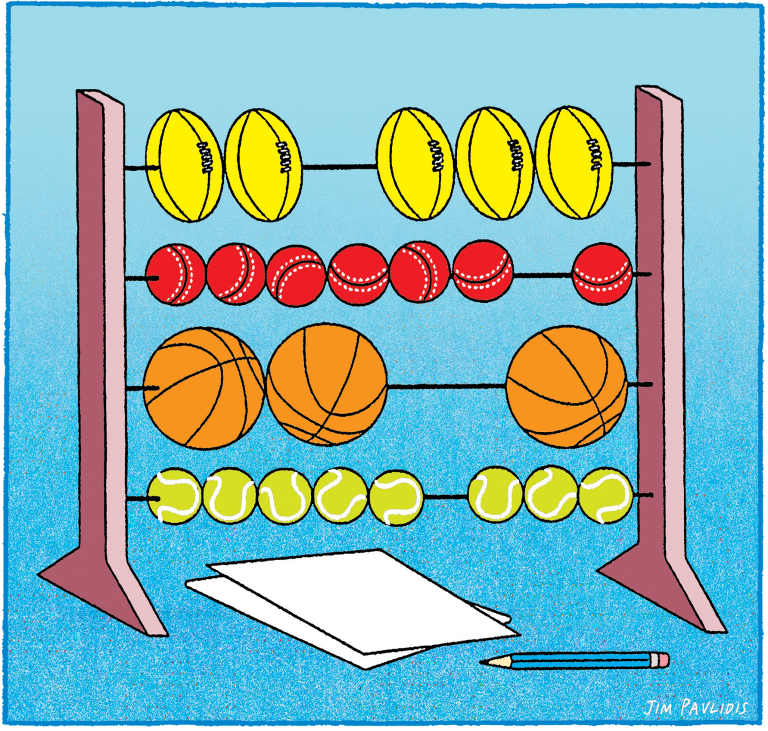Soon after a Red Sox outfielder had gloved a quite nice rolling catch in the World Series this week, a commentator told us he had been a 17 per cent chance to take it. It jarred like a mishit. Three thoughts leapt nimbly to mind. One was: bullshit. He had a mitt; all he had to do was get to it to take it. The next was: how do you make a calculation like that anyway? The third was: why?
Suddenly, we were quantifying the catch instead of qualifying it, let alone appreciating it and far from feting it. To what purpose? Did appending a number sharpen our admiration? Would an annotated degree of difficulty have added anything to our understanding of the mastery of Shane Warne's ball-of-the-century in 1993, or the nerve of Leo Barry's mark in 2005, or the consummate skill of Dom Sheed's premiership-winning goal this year?
Playing the percentages: Three LA Dodgers raffle a catch in the outfield.Credit:AP
There probably was a figure attached to Sheed's kick, and a graphic, but did it take into account the unfathomable pressure of the moment? Lou Richards would have said the angle was so tight that ball was at risk of getting jammed between the posts. No diagram or statistic could have been more graphic. As for our baseballer, the calculus once would have simply concluded: "Fat chance".
Sometimes it seems that everything in sport must be computed, codified, digitised and data-banked before it can be a thing. (The same reductionism applies to nicknames, progressively stripping imagination from them until we end up with Prime Minister ScoMo.) This is not to say that statistics are not useful, just that they can be overdone. Instead of enlivening, they deaden; instead of enhancing our enjoyment, they get in the way. It used to be said of some that they used stats like a drunk uses a lamp-post, for support rather than illumination. Now it would be that he uses 82 per cent for leaning and 18 for light.
We think we're getting something while we're missing something. Dan Menzel wasn't sacked by Geelong because of statistics, but they were enlisted to the cause. His forward pressure was inadequate. This was reflected in a sophisticated suite of figures, far in advance of the average fan's understanding, we were told. "If there isn't a place for Dan Menzel," said Gerard Whateley, "then the game has moved too far." We don't really need numbers to see what he can't do, and we sure as hell without numbers can see what he can.
Not all this week was lost. Australian Olympic Committee chief Matt Carroll's address to the National Press Club made headlines for his call for more government money for sport – standard AOC lobbying business. Missed were two real developments, the welcome detente between the AOC and Sport Australia, formerly Australian Sports Commission, and this from Carroll: "I can tell you we will not be setting medal targets for Tokyo 2020."
Sometimes it seems that everything in sport must be computed, codified, digitised.Credit:Jim Pavlidis
When the Crawford report first proposed a shift away from from medals-merit metric in 2009, it was as well received as a fart. Since, as Australia's Olympic return has declined, foreshadowing medals and funding accordingly has been shown up for the shallow, bean-counting exercise it is, lacking nuance, skewing the fair go. It marked down team sports, marginalised popular but intensely competitive sports, favoured arcane but winnable pursuits, and had everyone looking over their shoulder, all because the numbers said so. As Carroll admits, the athletes hated it. Now it is gone, or should I say, re-factored to 0.
In any case, stats tend to be used not to predict, but to rationalise. Of course, the Bulldogs would win the premiership in 2016, and Richmond last year, and Collingwood this year, almost. Look (back!) at the numbers. The great journalist and writer Les Carlyon once said that one of the reasons he admired sports writers was that they did not justify their awry weekend predictions on Monday by saying that they were right in seasonally adjusted terms. Now I'm not so sure that we can rest on those laurels.
The trouble is that there is a figure for every contingency now, and it is easier to say what counts than what matters. There is even a figure on my screen for how probable it is that you read to the end of this column. It's pretty low – but, proving my point about the reliability of numbers, here you are. Thank you.
Source: Read Full Article

